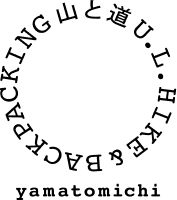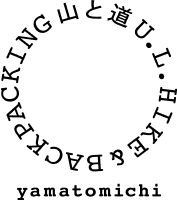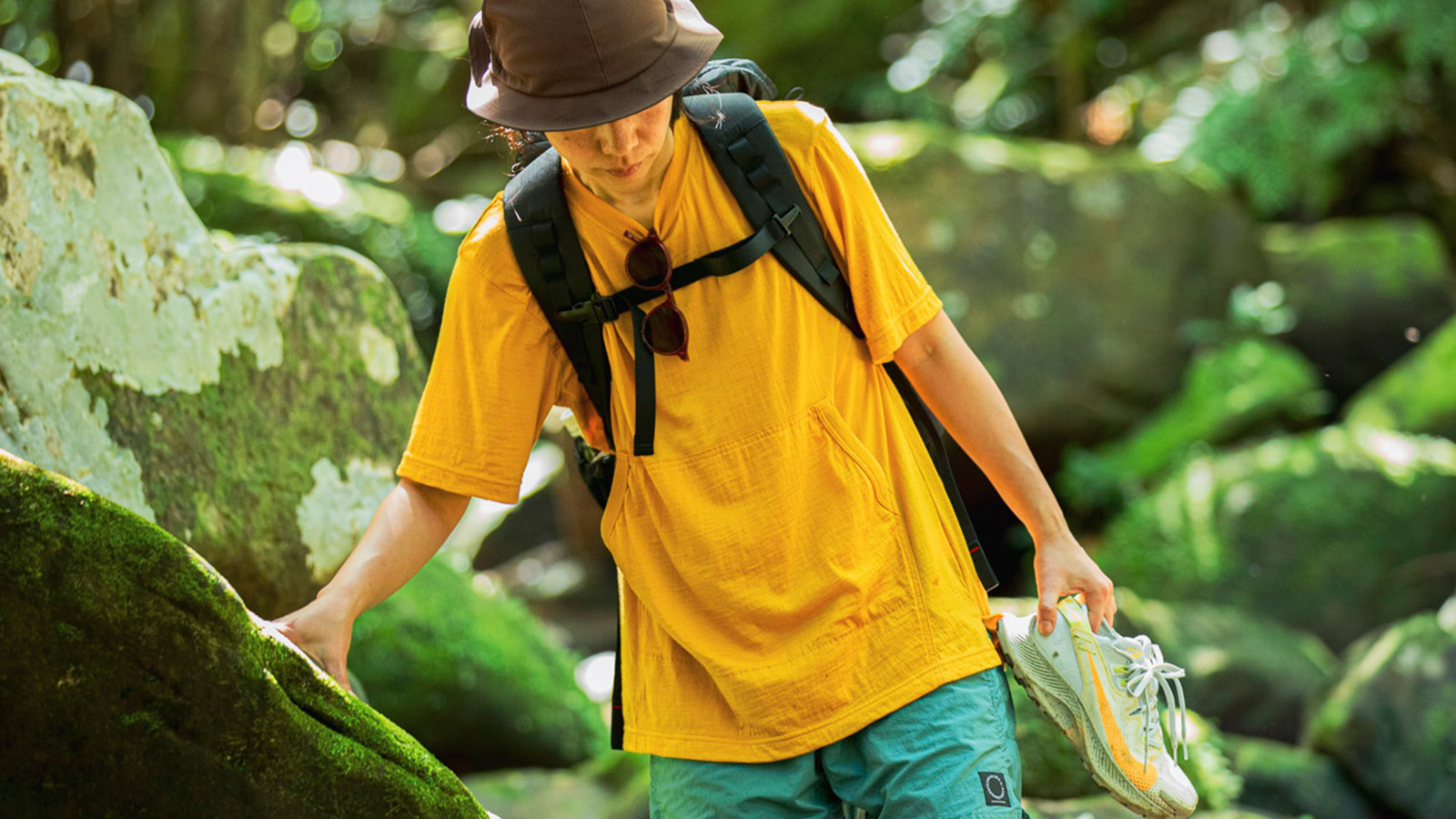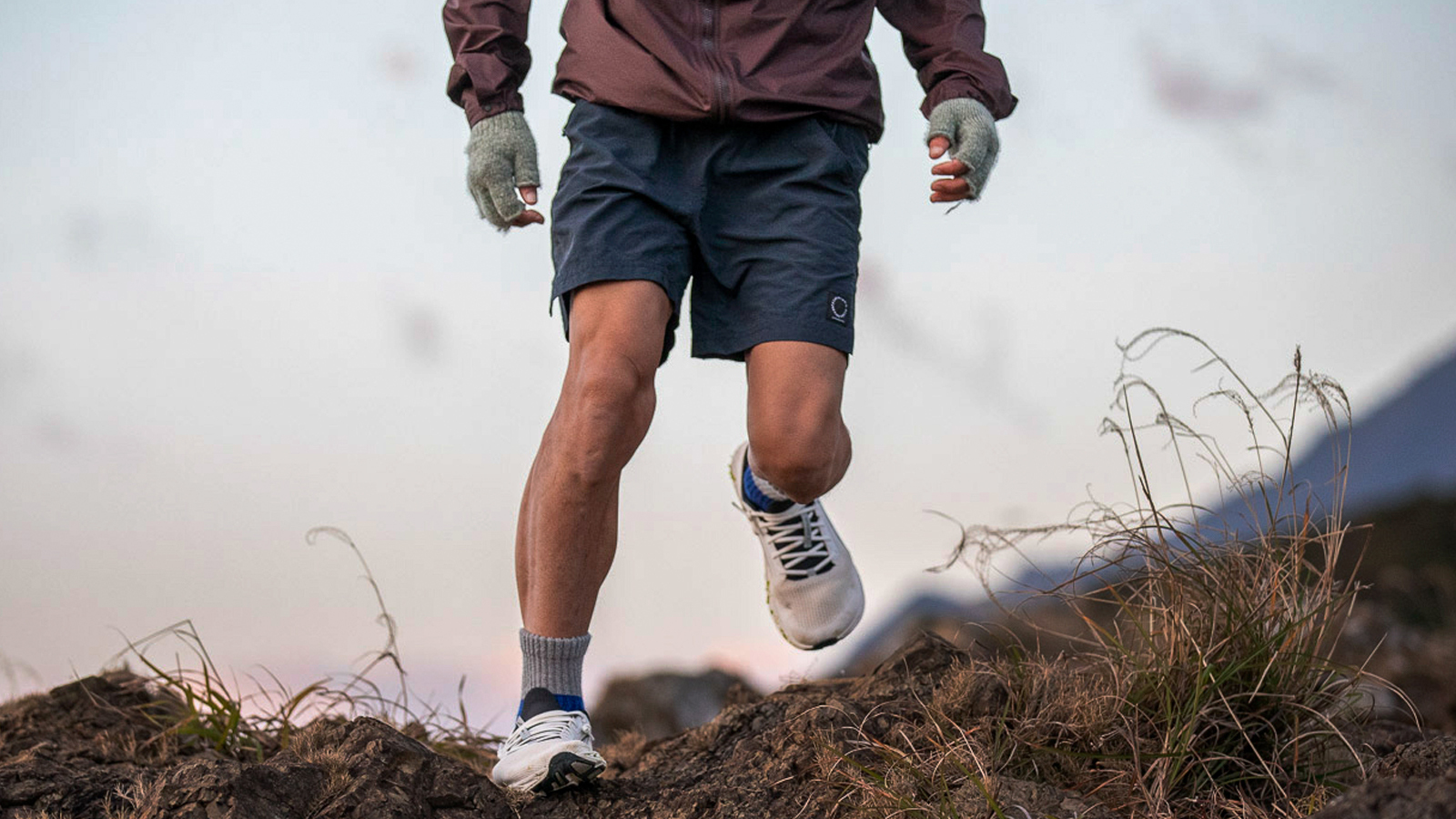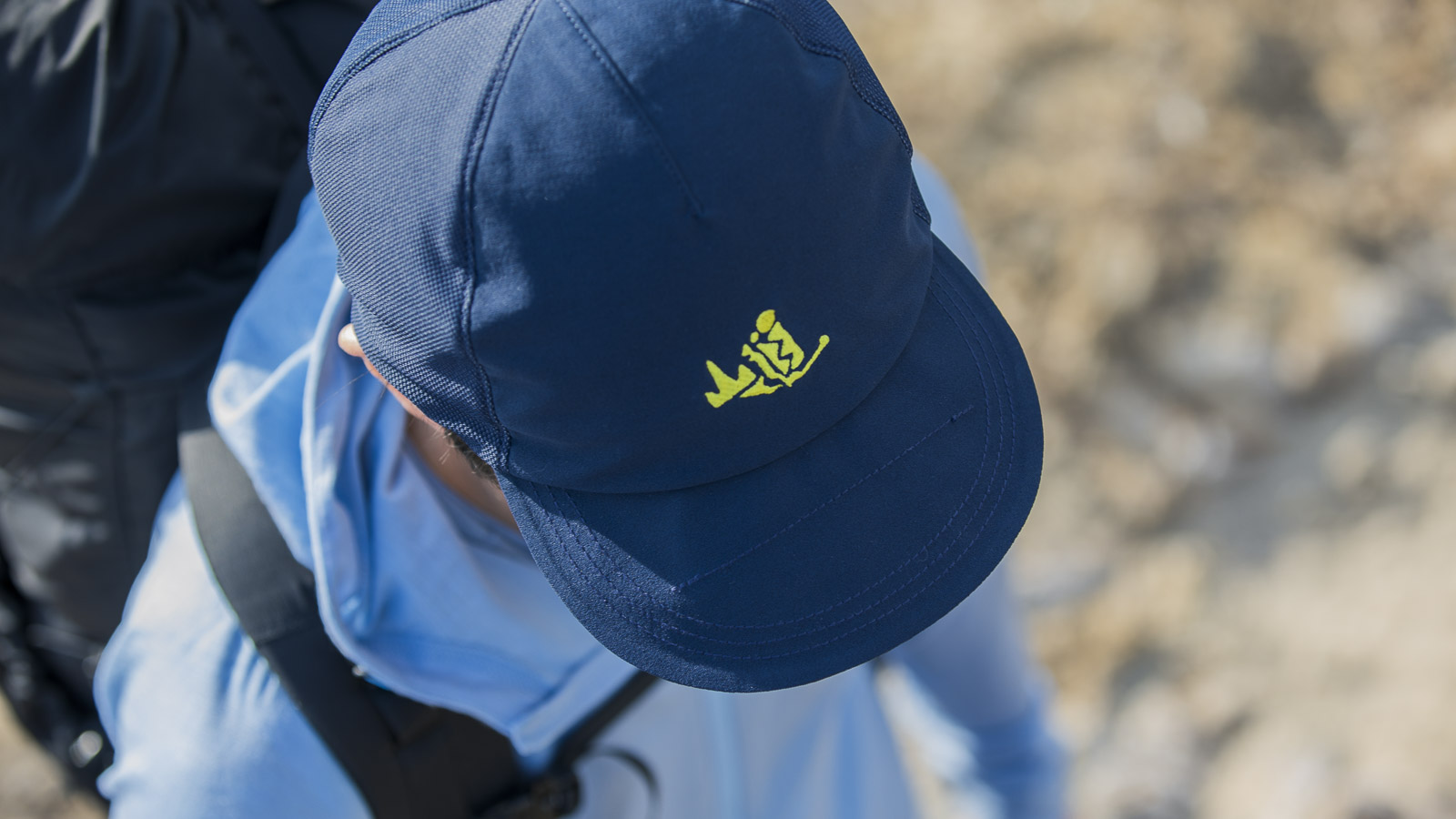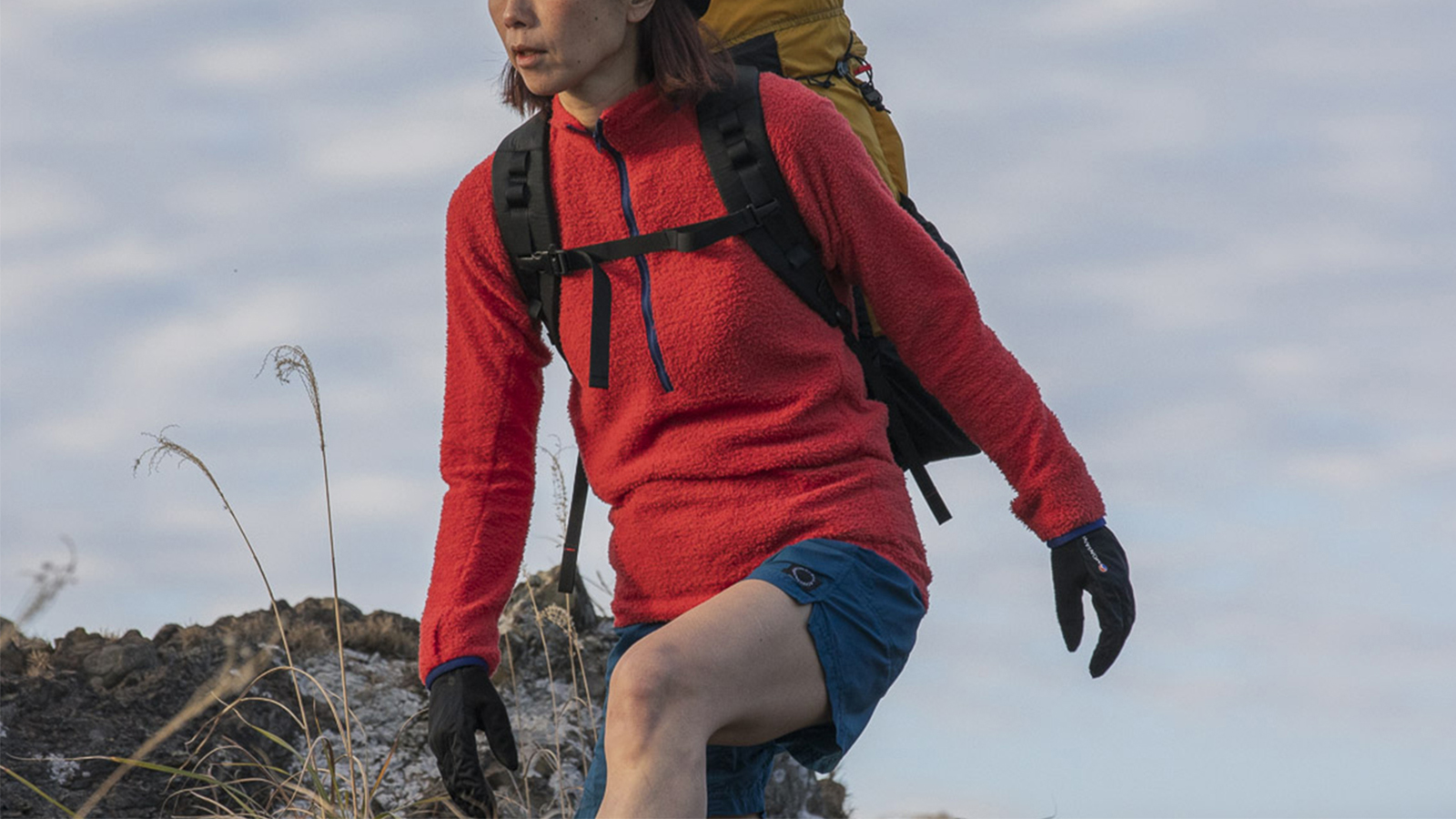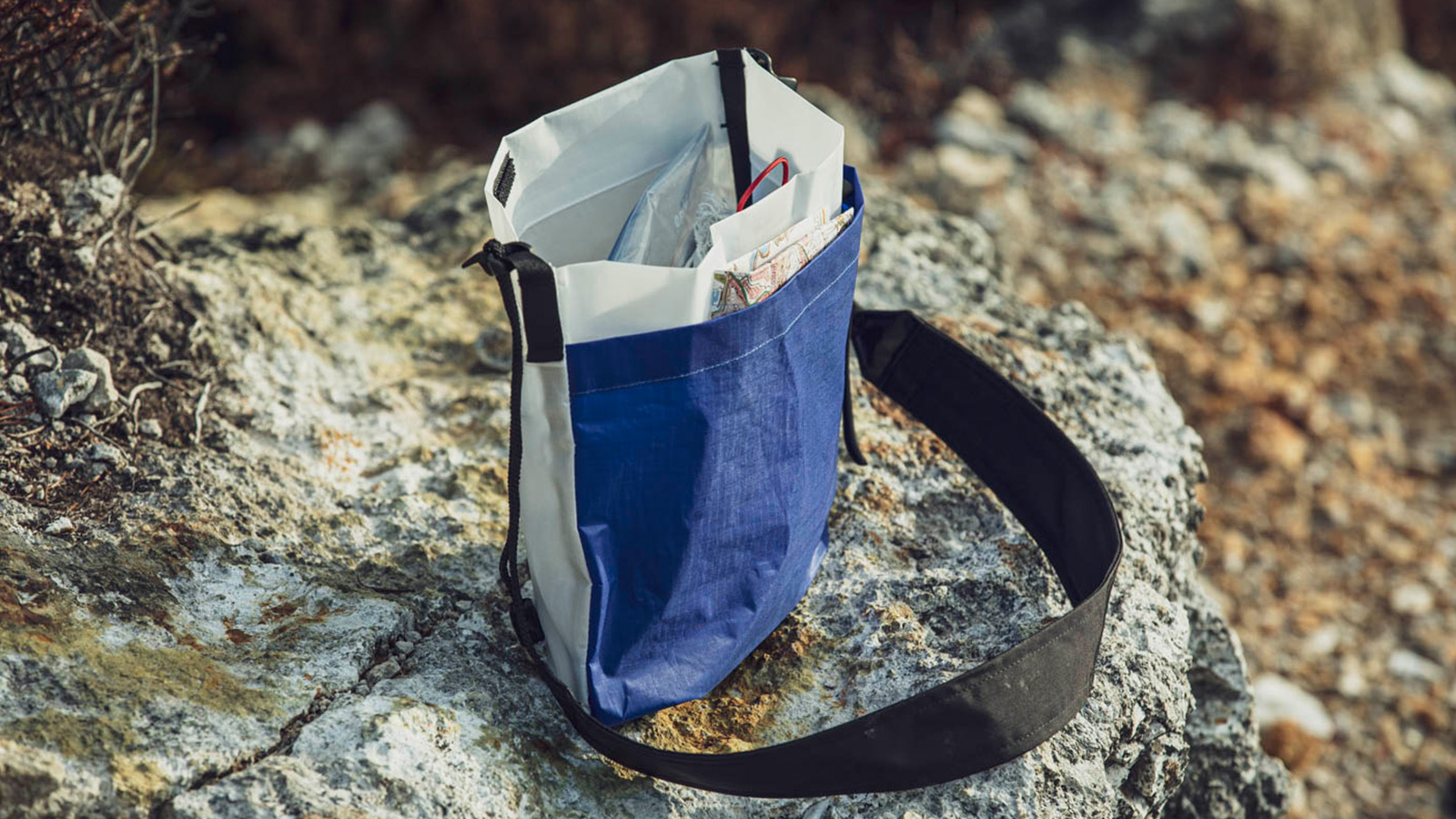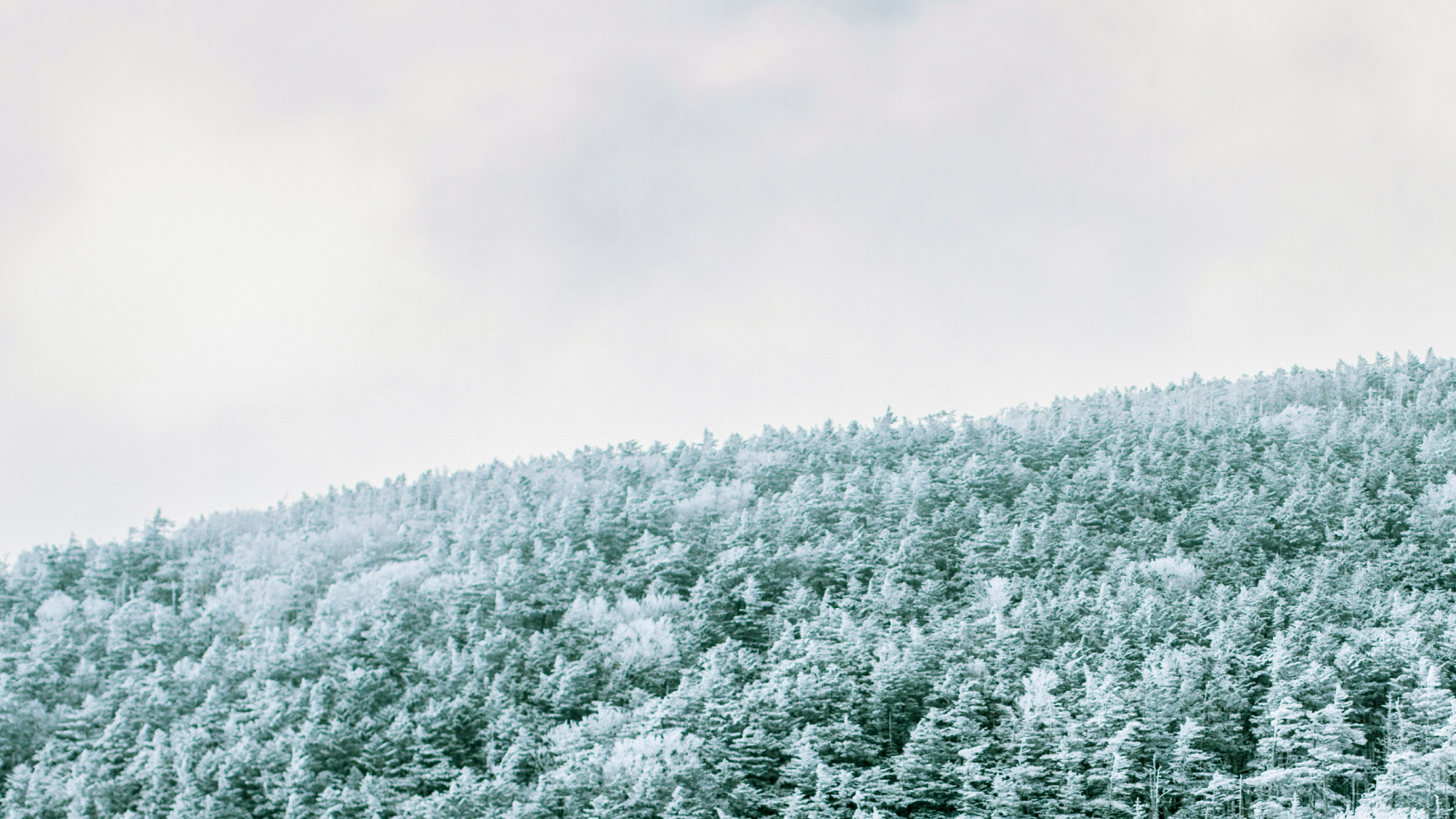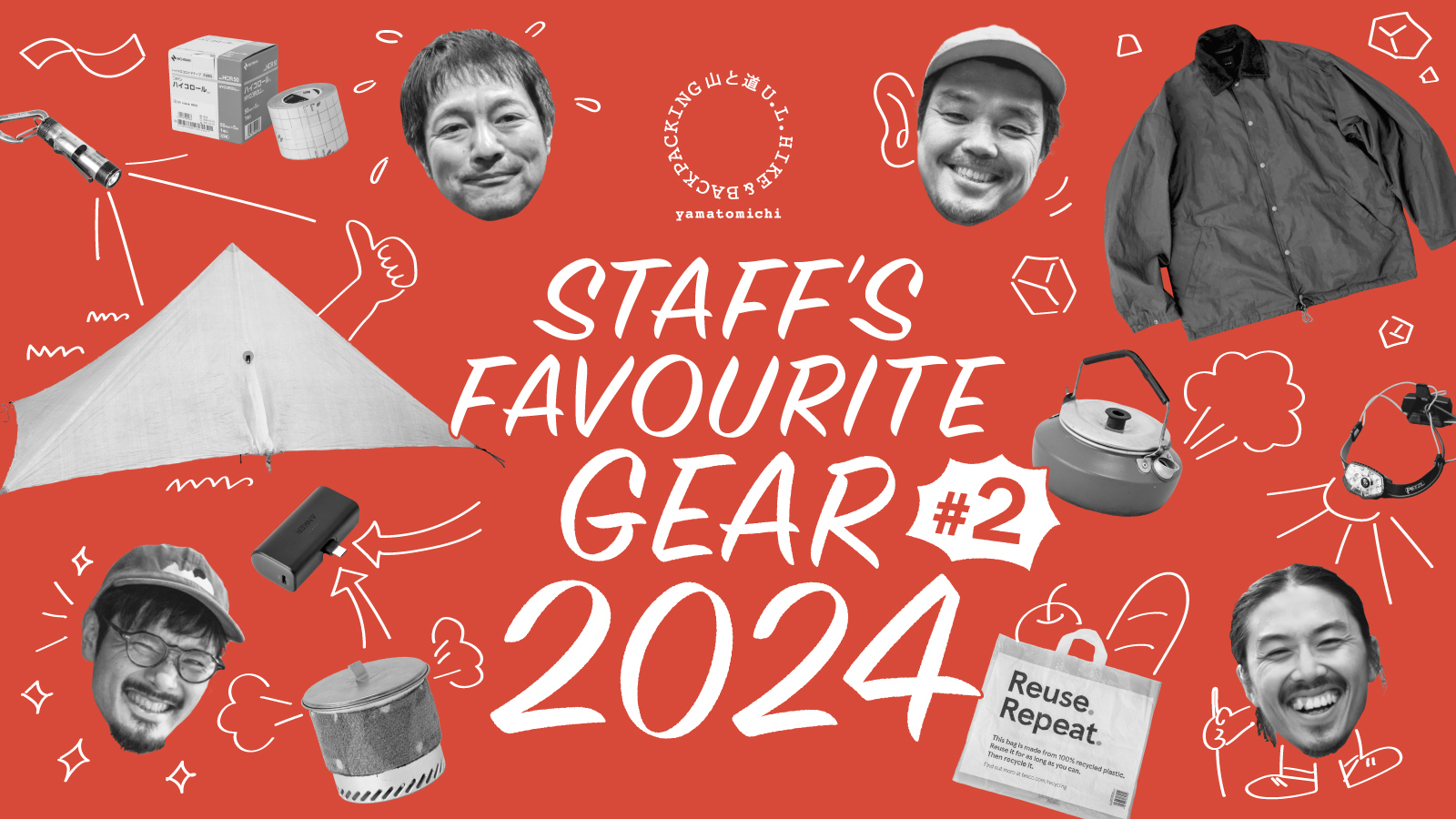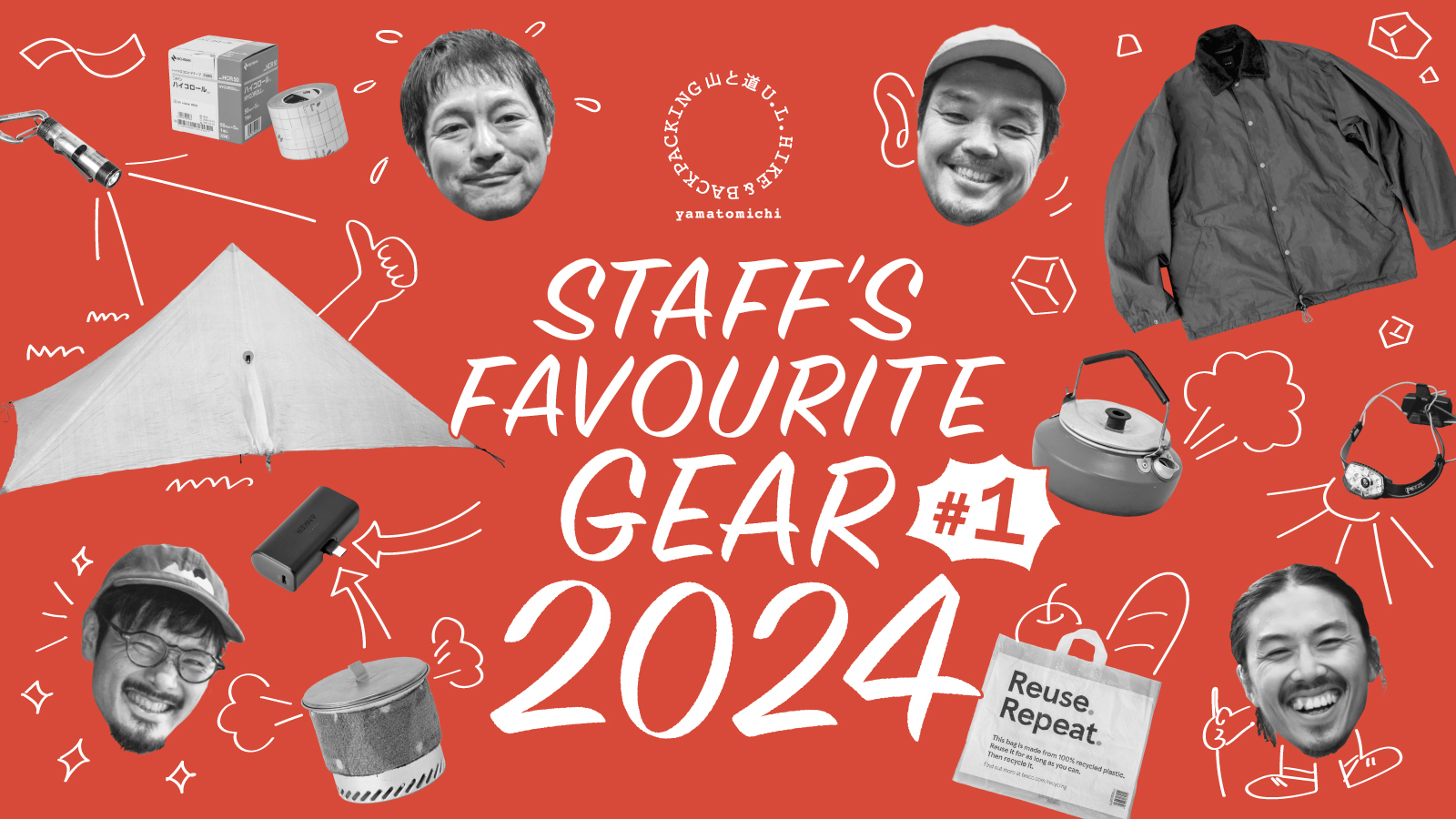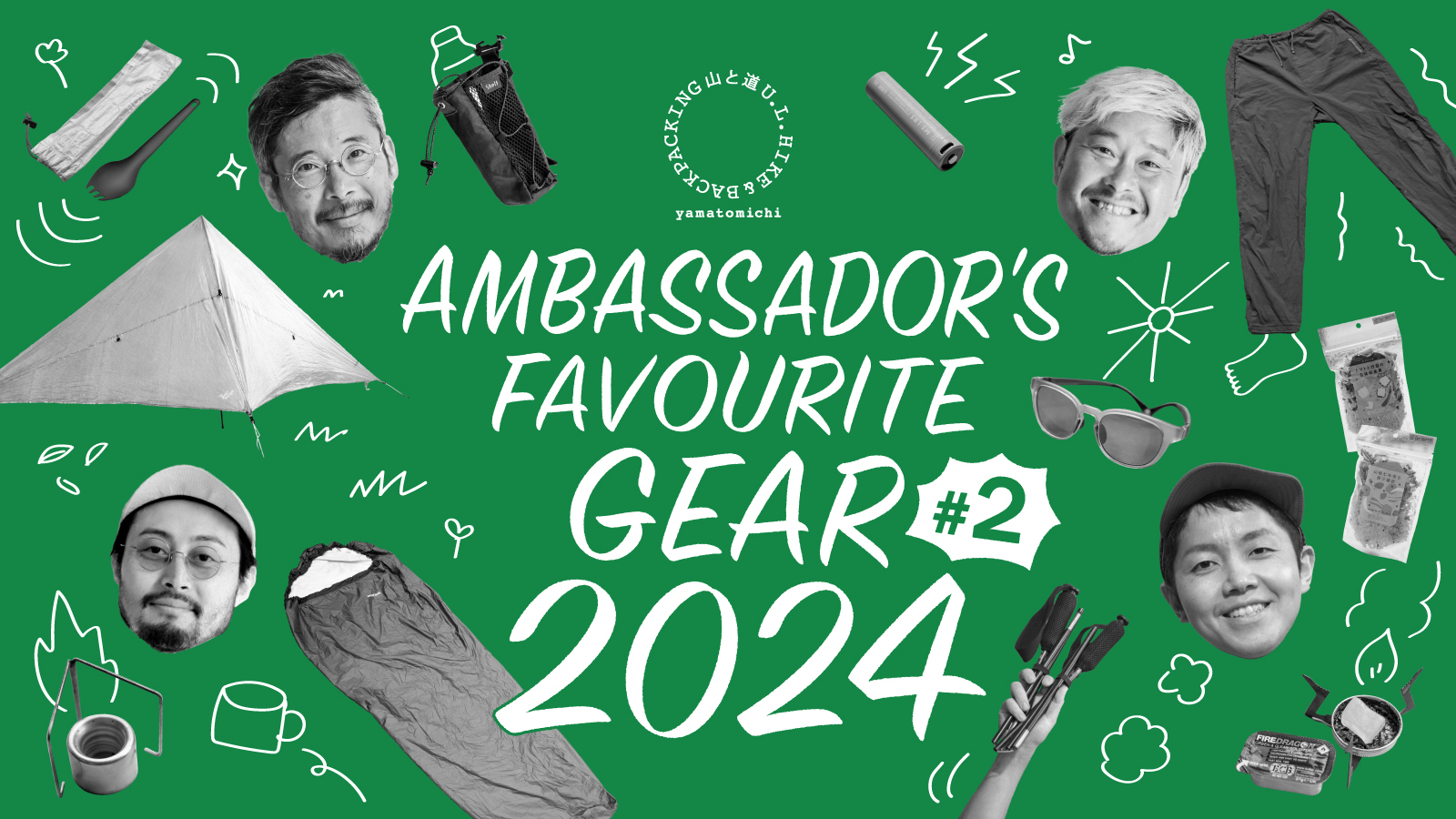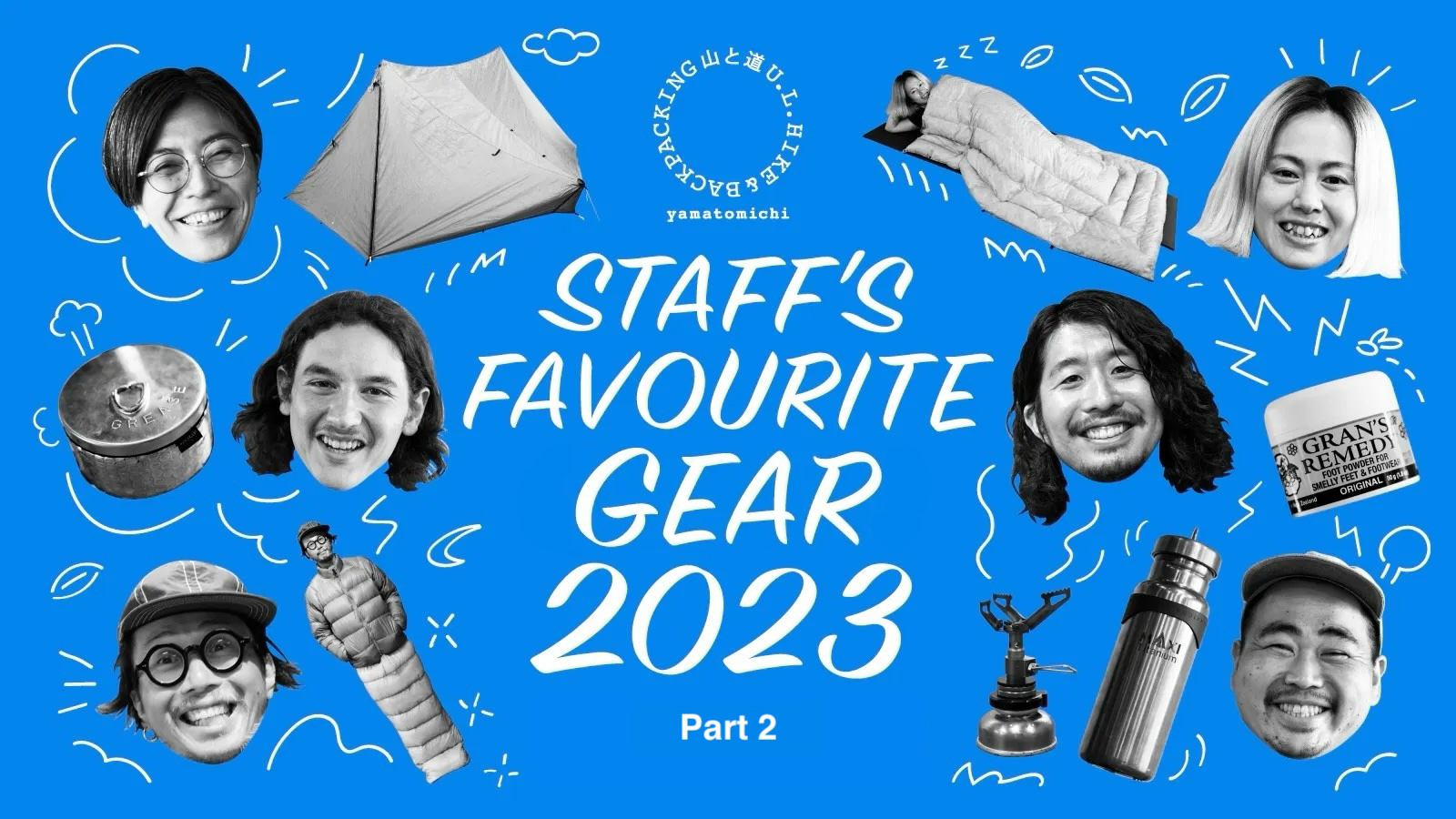Yamatomichi Kyoto Shop Staff #1
Support: Seimi Rin
Yamatomichi Kyoto Shop Staff #1
Support: Seimi Rin
In the hiking community, there are plenty of gear nerds who love to talk about their stuff. Yamatomichi employees are no exception. Recently, we asked the staff at Yamatomichi Zaimokuza in Kamakura and Yamatomichi Kyoto to tell us all about the things they can’t do without on the trail. Our employees aren’t all seasoned ultralight hikers. Some are long-trail thru-hikers; others are outdoor novices. For the second installment of this two-part series, Yamatomichi Journals’ Masaaki Mita speaks with three staffers at Yamatomichi Kyoto: Ryo Kubota, Yusaku Andoh and Ayana Nagai.
Our previous episode covers our Kamakura staff’s favorites. You can view that article here.

Yamatomichi Kyoto’s staff: (Top row, L to R) Akihiro Yamamoto, Ryo Kubota, Ryota Mabuchi, Yusaku Andoh; (Bottom row, L to R) Mayumi Syoji, Ayana Nagai.
Ryo Kubota’s Gear Recommendations

Ryo Kubota was born in Otsu, Shiga prefecture. His YouTube channel, Miso Shiru Egao (Miso Soup Smile), focuses on trekking in the mountains and his home prefecture. His first full-time jobs were in daycare centers and child rehabilitation facilities. After cycling around Japan, he moved briefly to Hokkaido, where he’d hoped to become a dairy farmer. An avid camper and hiker, he became interested in ultralight hiking after growing tired of trekking with a heavy pack. He now finds joy in living frugally and getting by for days with few belongings –– notably, his 24-day hike on the Shiga Perimeter Trail.
From Camper to the World of UL Hiking
Q: Let’s start with an introduction.
RK: I’m Ryo Kubota from Yamatomichi Kyoto, where everyone calls me Ryo-kun.
Q: You have another nickname, I hear.
RK: I’m also known as “Miso Shiru Egao” (Miso Soup Smile), the name of my YouTube channel.
Q: The charismatic YouTuber.
RK: I’m not even remotely charismatic.
Q: Come on. Not even a little bit? How often do you climb mountains, Ryo-kun?
RK: My first hike into the mountains was about 10 years ago. On that trip, my friend made ramen on a burner. I wasn’t so much hooked on the mountains as I was obsessed with the gear, and after that I started heading to campsites in my car. I went all out –– equipment, big tents, etc. Over time, I started wondering what I was doing. I’d drive out to a campsite, set up my tent and stove. And even though it was just me, alone, I’d line up two chairs.
Q: That does sound a bit pointless.

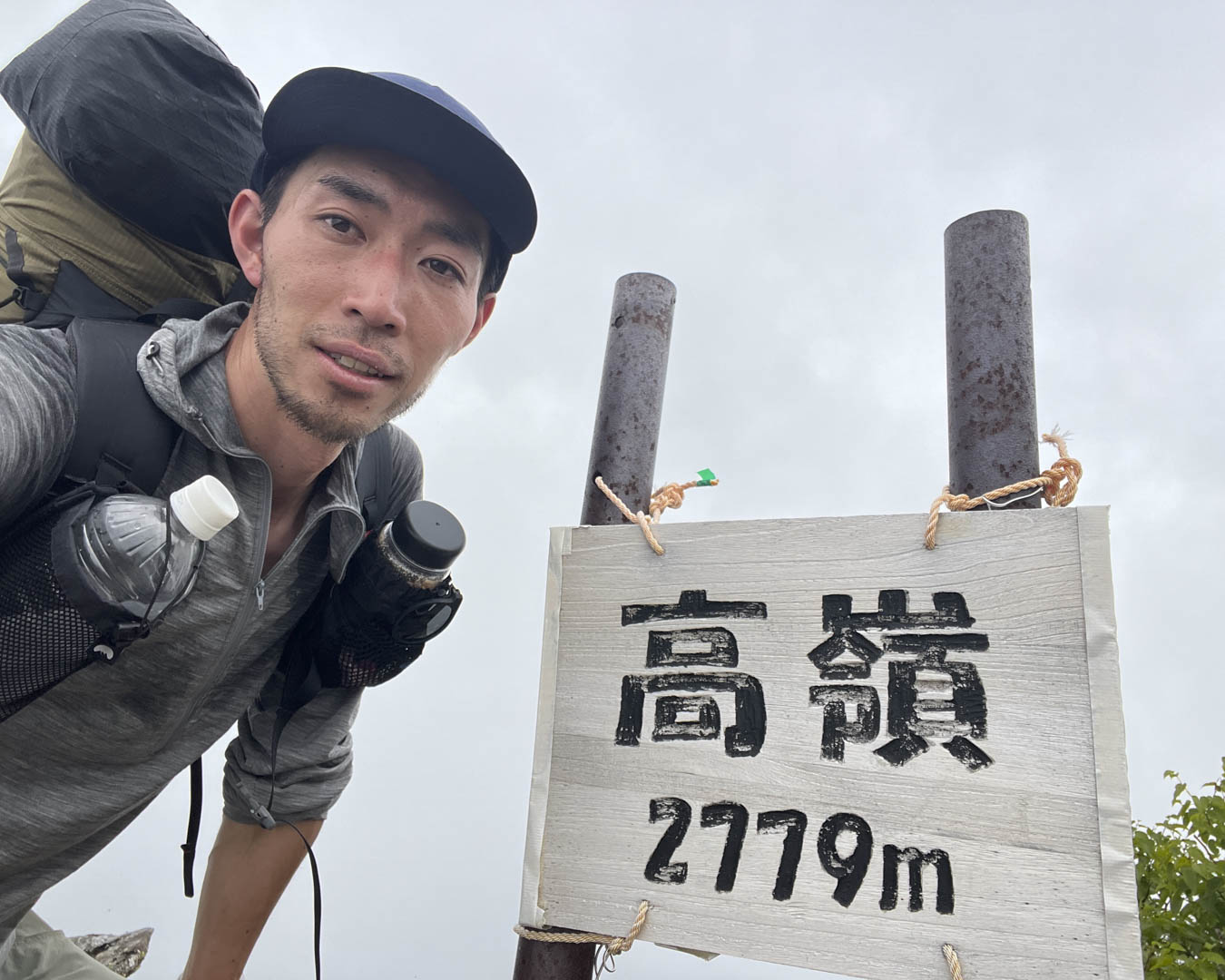
RK: After arriving at a campsite, I’d mostly just sit around, occasionally skipping stones in the river. It started to feel pointless. Back then, about 90% of my hobbies were focused on camping, and the other 10% on hiking in the mountains. But that 10% gradually grew until camping and hiking were about equal. Then, I went to Japan’s Northern Alps with some friends and was blown away by how different the scenery was. That got me hooked. Until then, I’d mostly been going to places like the Suzuka and Hira Mountains.
Q: It’s like you were thinking: “What was I doing camping all this time?!”
RK: Exactly! And I realized that I could do it with less gear. I didn’t need to load everything into a car.
Q: Once you start camping on top of a mountain, camping at the base just doesn’t cut it anymore.
RK: That’s right. And back then, even in Japan’s Alps, spending a night at a mountain campsite cost only ¥1,000. I thought: It’s cheap, I’m going up on my own steam –– this is the best! After that, I started going on hikes regularly, carrying about 17 kg for a two-day trip. About five years ago, I was on Mt. Hakuba when I almost toppled over as I tried to put on my crampons because of the weight of my pack. I realized how dangerous this was and started looking into lightweight gear. Around that time, I visited Yamashokuon (a KYoto shop that sold Yamatomichi products) and bought the Yamatomichi THREE backpack, and that’s what got me started with ultralight hiking.

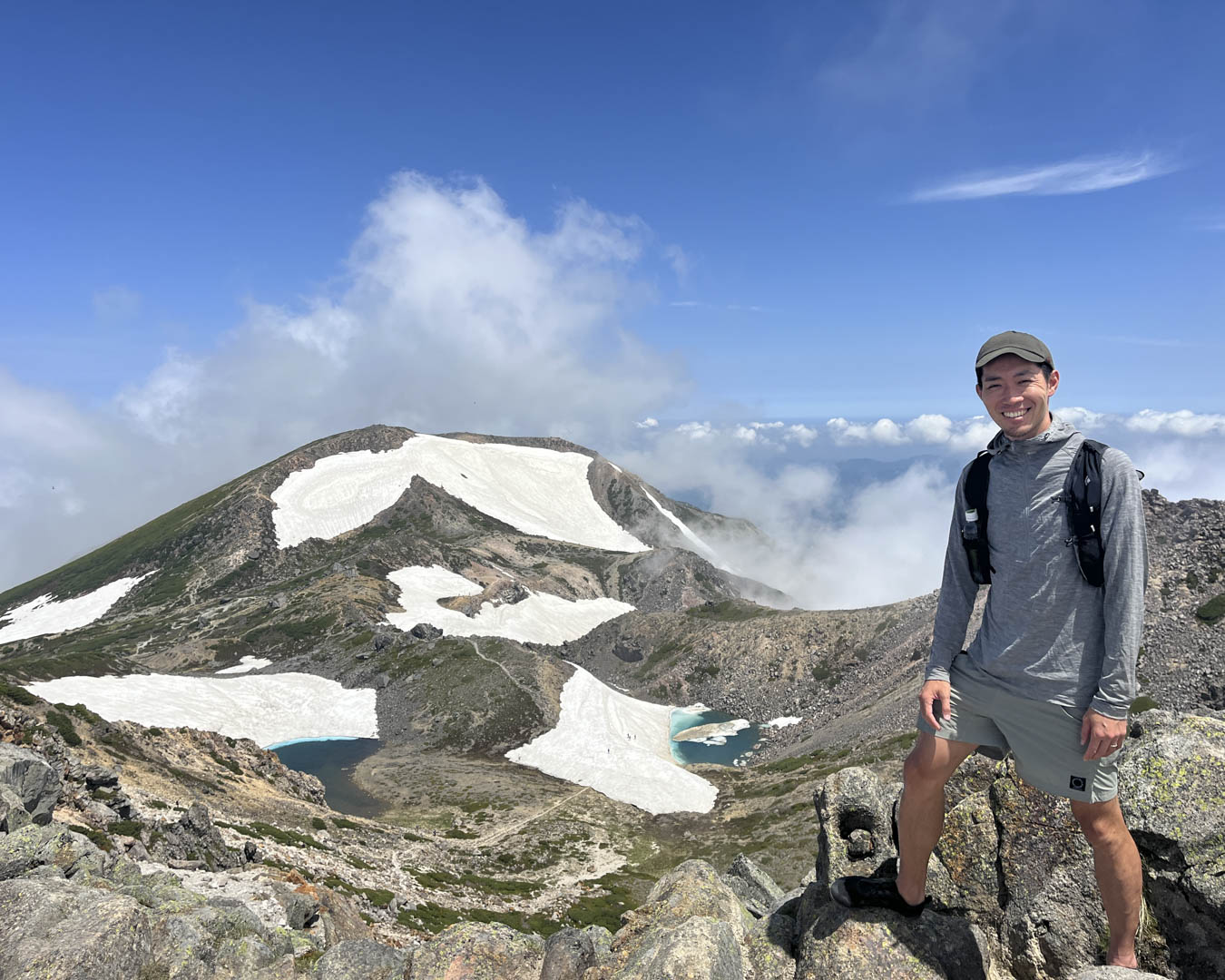
Q: What led you to join Yamatomichi?
RK: I joined a year ago. Before that, I was working in childcare and was a regular customer at Yamashokuon (the predecessor to the Yamatomichi Kyoto shop) in Kyoto. Then I went hiking with Mayumi Syoji, who is now my colleague. At the time, she mentioned that the shop was short-staffed and asked whether I’d like to work with them. I told her that I was actually thinking of quitting my job.
Q: So, your life changed thanks to Yamashokuon. Let’s have you talk about your favorite gear now.
1. Tritensil Mini

RK: The first one is the mini version of the Tritensil. I bought it about two months ago. Before that, I had been using a spork for about four years.
Q: The one that folds in the middle?
RK: Yes, the plastic one that folds. I had no complaints but I lost it. I was wondering what to do when I noticed some people around me using the Tritensil, so I decided to give it a try. The moment I bought it, I realized the spork had actually been a source of stress for me.
Q: What was stressful about using it?
RK: A spork feels like it’s 70% spoon or 60% fork –– it’s trying to be both but isn’t succeeding at either. On the other hand, the Tritensil has separate utensils, so you can scoop up noodles. When you’re eating noodles, it’s 100% a fork. When you’re eating rice, it’s 100% a spoon. It even has a knife, so if you’re carrying a baguette, you can cut it. And if a friend forgets their cutlery and I’m having rice while they’re having noodles, I can lend one of my utensils to them, which is really nice. You can also adjust the length, which comes in handy when using slightly deeper bowls.

Q: Does it bother you that the fork and spoon are attached to the same handle?
RK: When I switch between them on a day after eating something oily, it can be a little annoying, but by then, my body is already dirty, so it doesn’t really bother me that much.
Q: So, it’s mostly stress-free?
RK: For now, yes. The storage length is a bit long, though. I’d prefer to store it inside my cookset but it doesn’t fit. Even so, it’s the least stressful tool I’ve used so far. It feels rigid, too. It’s so user-friendly that since I started using it, I’ve come to realize that things I hadn’t thought were stressful before actually were.
2. Mont-bell Trekking Umbrella 50

Q: What’s next?
RK: The Mont-bell Trekking Umbrella 50. The first time I used an umbrella while hiking was in the forested Kamegamori area of the Ishizuchi mountain range, in Ehime prefecture, on the southwestern main island of Shikoku. I had a Uniqlo folding umbrella, and even that was comfortable carrying around. It made me feel that there aren’t many places on ordinary hiking trails where an umbrella would be in the way.
Q: Exactly.
RK: Which is why I thought that an umbrella was a good idea. I bought a Silver Shadow Carbon Trekking Umbrella made by Beaverton, Oregon-based Six Moon Designs. It’s a good umbrella, but it’s longer than my backpack, so it would get caught on branches, and I didn’t like how noticeable it was when I wasn’t using it. My wife had a Mont-bell umbrella for everyday use, so I asked her if I could borrow it. It was about half the weight of the Uniqlo one, very easy to handle, and when closed, it was short enough not to get in the way. Since then, I’ve been using the Mont-bell all the time, treating it as if it’s mine. I even used it during my recent trek in Japan’s Southern Alps.
Q: You traversed Japan’s Southern Alps?
RK: Yes, during that trip, I used the Mont-bell umbrella with Yamatomichi’s UL All-weather Jacket. At around the 2,500-meter altitude mark, there were a lot of trails we were on where it was raining heavily but without much wind. I started off walking wearing only the UL All-weather Jacket, but the back of my pack and the areas under pressure from the shoulder straps got soaked inside, so I realized I needed to protect my back. For the next four days of rain, I used a combination of the UL All-weather Jacket and the umbrella, or just the umbrella without the jacket. While my arms and legs got wet, I didn’t get so drenched that I felt the need to change clothes immediately upon reaching the campsite.

Q: How did the umbrella handle the wind?
RK: Luckily, because I was mostly in forested areas, the wind wasn’t too strong. And when I was on the ridgelines, I closed the umbrella. The umbrella was incredibly useful. Without it, I would have been soaked during those four days of rain.
Q: When it comes to rain gear, an umbrella might actually be the best option. After all, generally speaking, umbrellas are used far more than raincoats.
RK: The umbrella works well as an add-on, especially when wearing the UL All-weather series, which is breathable but has low water resistance. And when you get to the campsite and need to go to the bathroom, it’s nice not to have to put on a wet rain jacket.
Q: With a small umbrella like that, you can carry it as a backup. I used to have one, but it was so small that I lost it almost immediately, and I haven’t gotten around to buying a new one.
RK: If I have to give this one back to my wife and get a new one, the Evernew 76g umbrella is another option. It’s lighter, but it has only five ribs, while the Mont-bell has six, which makes it more stable.
Q: Maybe I’ll buy one again.
3. High Tail Designs’ The Ultralight Fanny Pack "Low Poly"

Q: So, what’s next?
RK: The Ultralight Fanny Pack “Low Poly” made by High Tail Designs in the US. Last year, I walked the Shiga Round Trail over 24 days, but before I started, I wasn’t really feeling motivated. I wondered why and realized it was probably because I was going to be walking mountains near my home that I was very familiar with.
Q: You pretty much knew what to expect.
RK: Exactly. It was basically just the local border of my home prefecture. So, to lift my spirits, I decided to bring something new with me: I bought this fanny pack that I’d been curious about. Since then, I’ve been using it all the time. I keep different things in it depending on the situation—like a mobile battery, valuables, skincare products, or a backup lighter—but it’s the perfect size and that makes it so convenient.

Q: It’s a bit on the smaller side, isn’t it? Most waist pouches tend to be slightly bigger.
RK: It is small, but a trail map from publisher Shobunsha’s long-selling “Yama to Kōgen” series (covering 1,500 mountains around Japan) fits perfectly inside. I don’t have any complaints about it. I don’t wear it all day; during activities, I usually keep it inside my backpack. But at campsites or on the train ride to the trail, I have it out. It’s a waterproof pouch for valuables. The fabric is DCF (Dyneema Composite Fabric), so it’s sturdy, and even when I put heavier items in it, it doesn’t sag. Inside, it’s divided into two compartments. I like to keep my ramen shop loyalty card in the second compartment.
Q: The print on the inside is stylish, too.

Q: It’s a bit on the smaller side, isn’t it? Most waist pouches tend to be slightly bigger.
RK: It is small, but a trail map from publisher Shobunsha’s long-selling “Yama to Kōgen” series (covering 1,500 mountains around Japan) fits perfectly inside. I don’t have any complaints about it. I don’t wear it all day; during activities, I usually keep it inside my backpack. But at campsites or on the train ride to the trail, I have it out. It’s a waterproof pouch for valuables. The fabric is DCF (Dyneema Composite Fabric), so it’s sturdy, and even when I put heavier items in it, it doesn’t sag. Inside, it’s divided into two compartments. I like to keep my ramen shop loyalty card in the second compartment.
Q: The print on the inside is stylish, too.
4. Exped Splash 15 knapsack

Q: Next is this knapsack?
RK: Yes, this is the Splash 15 from Swiss brand Exped. The design is so simple that it really reminds me of the knapsacks we made in elementary school home economics class.
Q: Is it waterproof?
RK: Yes. It’s a dry bag, so the seams are sealed. When packing, I usually put my sleeping bag, insulation and clothes that I won’t need during the hike into the Yamatomichi Pack Liner and place it at the bottom of my backpack. But the layer above that –– with items like my cookware, rain gear and food –– is all mixed together and gets disorganized. So, I tried packing those items into this bag, and it worked really well. When I need to take things out, I just have to look inside this bag, which reduces stress and saves time. And because it’s waterproof, I don’t have to worry about things getting wet if it starts raining. I also use it as a summit bag when I reach the campsite or when I go to a hot spring. It helps keep things organized inside the tent, too. I just toss everything into it, and it clears up the clutter.
Q: So whenever you need to find something, you just check inside that bag.
RK: Exactly. It’s versatile and lightweight.
Q: It’s like having two sections inside your backpack.
RK: It helps keep things organized into sections A and B inside my pack.

Q: I mentioned this before (in the Yamatomichi Zaimokuza edition with Stephen Moss), but I also use the Zpacks food bag in a similar way. I just throw everything in –– food, cooking gear, electronics — and then I have a separate stuff sack for my sleeping bag and down jacket, and another for my clothes. The inside of my pack is divided into three layers. Having a bunch of small stuff sacks in your pack can be a hassle. If you had a big pack with lots of pockets, maybe dividing things up like that would work.
RK: I totally get that. That’s why I really like this setup.
Q: It’s also nice that it can double as a knapsack –– which I suppose is the normal way to use it.

RK: And it’s only about ¥4,600, so that affordable feel is nice too.
5. Jindaiji Mountain Works’ Hillbilly Pot 550

Q: And finally, we have a cooking pot, or rather, you’ll be talking about the entire stacking setup.
RK: That’s right. The cooking pot is the Hillbilly Pot 550 from Jindaiji Mountain Works. Back when I started shifting to lightweight gear, the first cooking pot I bought was the Evernew Titanium Pasta Pot 750.
Q: That’s the one with the strainer lid for draining pasta, right?
RK: Right. It also has a spout and a handle that’s easy to grip, so I really liked it. But it’s 750 ml, which is a bit large. Even when stacked, it had a lot of empty space inside, and my gear would rattle around. I decided that if I was going to get a smaller pot, I’d go for one without a handle, which led me to buying this Hillbilly Pot. I heard from a friend that Toaks’ titanium pot without a handle would fit perfectly inside, so I gave it a try. Both are 550 ml, and they really do fit perfectly together. I also have a Munieq windscreen that doubles as a stove stand inside, and it fits just right too.

Q: Is this your stove?
RK: Yes, a friend made it for me. He told me that he wanted to make a carbon felt stove using this can, but Amazon only sold them in packs of 24, so he had a bunch and he made one for me.

Q: So you stack it with a foldable cup, fuel bottle, and lighter. How do you like the Munieq windscreen?
RK: It’s good. You can adjust the diameter, it’s stable, and it blocks the wind while still allowing airflow, so my fuel efficiency isn’t bad. The only downside is that it stays hot for a long time.
Q: Does it stay hot even after boiling water?
RK: Exactly. So when I’m in a hurry to get going, it can be a bit of a problem. Generally, I don’t boil water for meals outside of campsites.
Q: So if you have coffee right before you leave in the morning, it’s still hot when you want to pack up.
RK: That’s why I start boiling water as soon as I wake up so I can drink it right away. But I think it’s good that it’s sturdy, so it doesn’t tip over, and it’s a perfect match for the diameter of this pot.

Q: Have you settled on this setup?
RK: I feel I can do everything with this. I was never interested in stacking, but then I tried it… The Hillbilly Pot is aluminum, and the Toaks pot is titanium, so I cook rice in the Hillbilly and boil water in the Toaks. Basically, I use the Hillbilly Pot for things that might get dirty and keep the Toaks clean inside. So, when I make instant noodles, I use the Hillbilly.
Q: And after eating, you just put it all away?
RK: I just put it away without wiping it.
Q: But doesn’t that make the outside of the Toaks dirty?
RK: It does, but it’s just the outside. If the outside of my house gets dirty, I’m fine with that.
Q: Not like worrying about your car getting dirty.
RK: As long as the inside is clean, it’s all good.
Q: Do you use a handle?
RK: I don’t use anything, as long as it’s not too hot to hold. Since aluminum conducts heat well and stays hot, I wrap a glove or towel or my Yamatomichi Light Alpha Tights around it before eating.
Yusaku Andoh’s Gear Recommendations

Yusaku “Andy” Andoh was born and raised in Nagoya, Aichi prefecture. He joined Yamatomichi, after being persuaded by co-founder Akira Natsume during Yamatomichi’s reception party in Kyoto. Although Andoh already owned a MINI2 backpack, he was mainly a runner and trail runner –– a member of HAR, a running team in Osaka and Kyoto –– and only had some day-hiking experience. He’s still learning about ultralight hiking and has plans to run the ULTRA-TRAIL Mt. FUJI.
Trail Runner and Former Sento Bathhouse Staff
Q: Please briefly introduce yourself.
YA: I’m Yusaku Andoh, a staffer at Yamatomichi Kyoto. Everyone calls me Andy.
Q: How long have you been working at Yamatomichi?
YA: Several months. I’ve been hiking for two years, but I haven’t done any overnight camping yet. I’ve mainly been focused on running and trail running, so I think I’m unique among Yamatomichi’s staff. The gear I’ve chosen reflects my background.
Q: Is Kyoto a good place for trail running?
YA: It is. There’s the Kyoto Trail, which is a 70-km trail near here, and Mt. Hiei, where trail running races are held. If you go west, there’s Mt. Atago, where Atago Gongen is worshiped as a protector against fire and a god of war and victory. It’s relatively easy to get to the mountains from Kyoto city.
Q: Kyoto is surrounded by mountains on all sides except the south.
YA: Right. And there are plenty of good mountains in neighboring Shiga prefecture, so it’s quite a convenient area for trail running.
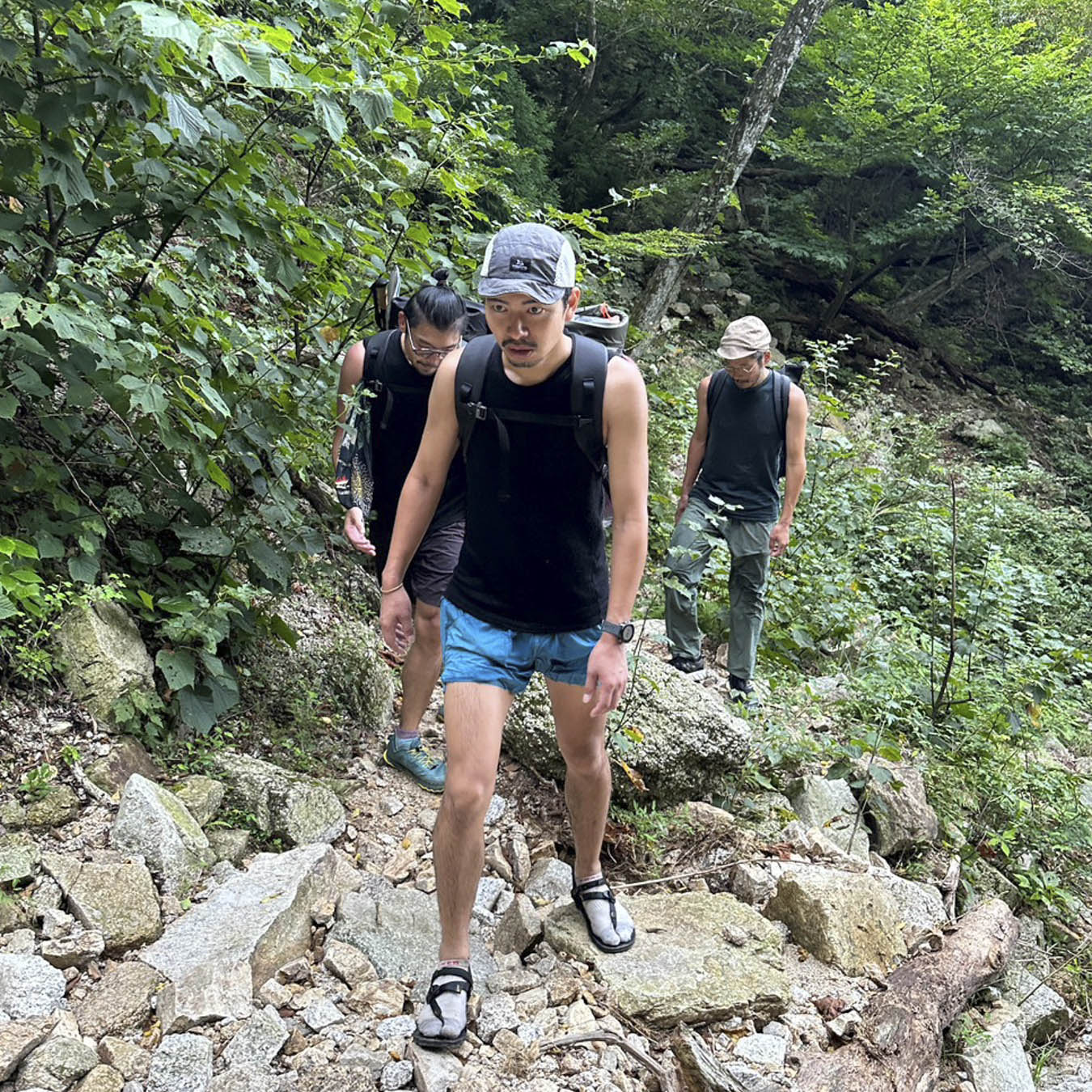
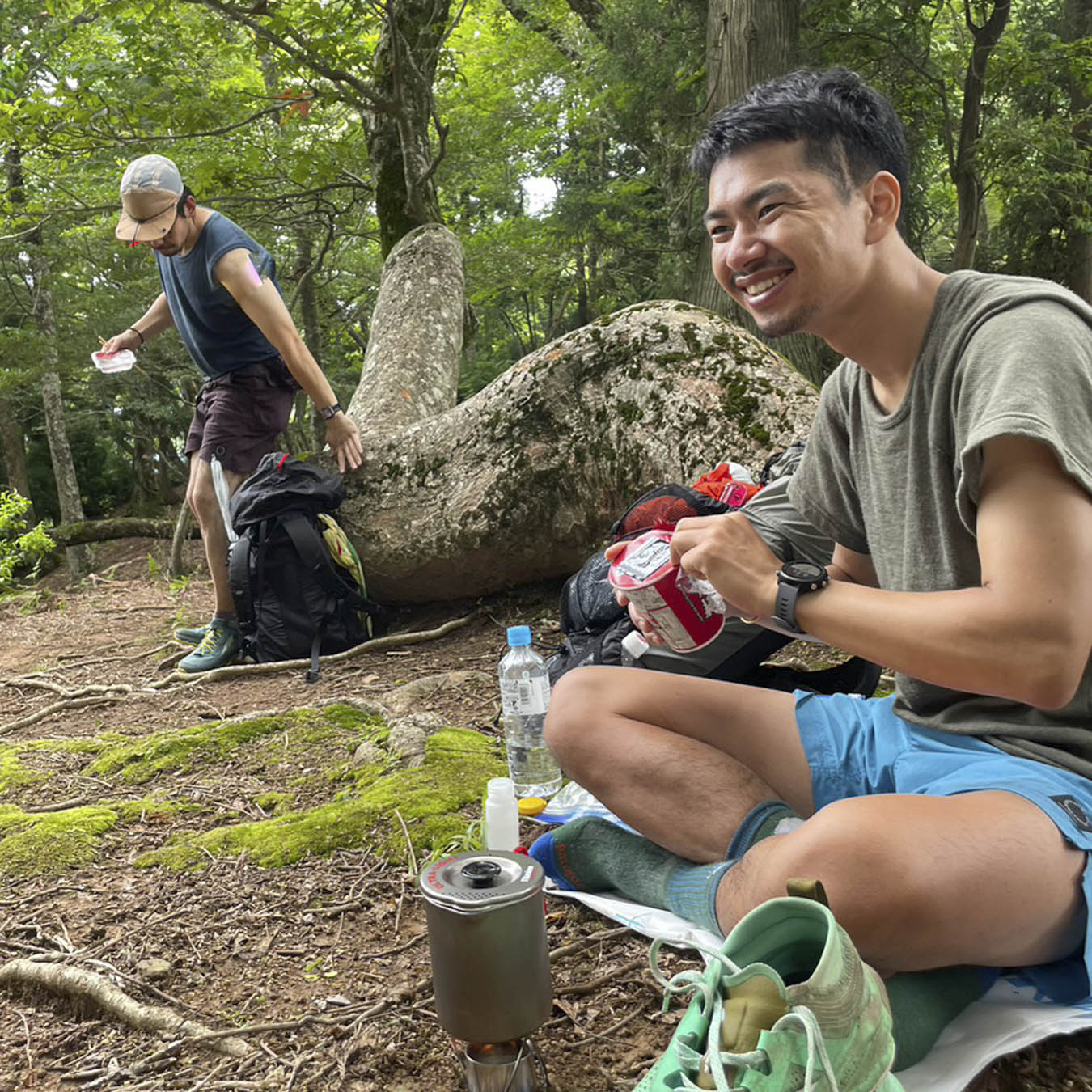
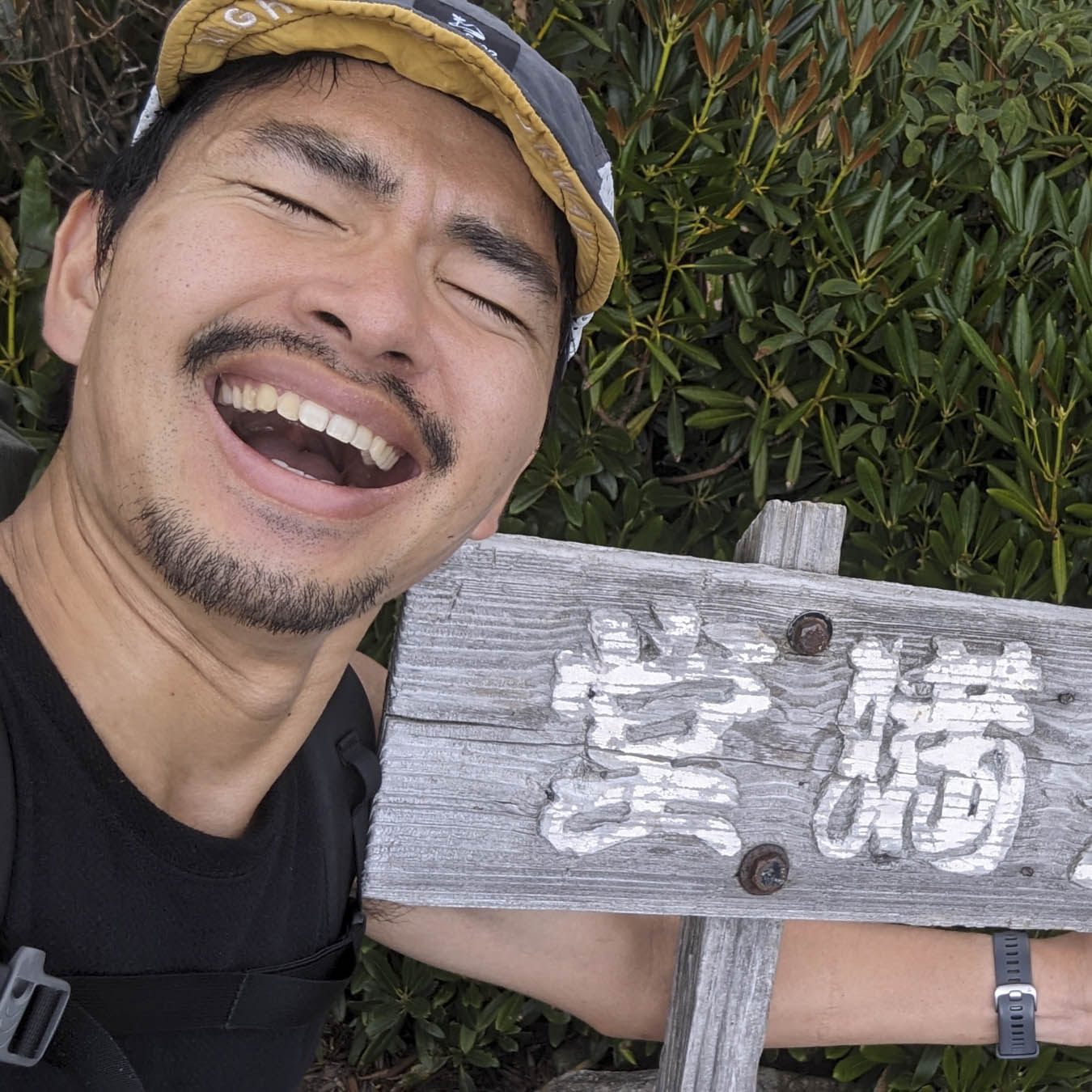
Q: What was your reason for joining Yamatomichi?
YA: Actually, it was because I attended the reception party when Yamatomichi Kyoto first opened. I was working at a public bathhouse nearby at the time.
Q: You were working at Sauna no Umeyu, which is like a sacred spot for sauna enthusiasts in Kyoto, right?
YA: Yes, I was employed by the company that runs the bathhouse. When Yamatomichi opened their Kyoto store, they bought an advertisement on the mirrors at Sauna no Umeyu. That might have been the reason I was invited to the reception party.
Q: So you were there representing Umeyu?
YA: Yes, and while I was attending the reception party, Yamatomichi’s co-founder Akira Natsume approached me and said, “Why don’t you come work with us?” At the time, I didn’t even know who he was, so it was quite a surprise.
Q: So you didn’t know about Yamatomichi, either?
YA: I started hiking two years ago, I bought the Yamatomichi MINI2 backpack from the Yamashokuon shop. Also, I had been watching Ryo Kubota’s Miso Shiru Egao YouTube channel, which really influenced my hiking trips. Most of my gear choices were practically copied from him, but I could only afford the cheaper options.
Q: So let’s go over your gear recommendations?
1. Nike Zegama shoes

YA: First up: my Nike Zegama shoes.
Q: These are the Nike thick-soled trail running shoes?
YA: Yes. I decided to compete in a trail run in Shiga prefecture called the Fairy Trail. I had some concerns about my knees, and thought it would be better if I got shoes with cushioning. Plus, I think the Zegama’s design is cool.

Q: How was it?
YA: I wore them during the trail run, and as I’d expected, the grip is a bit weak. I slipped a few times, but the Fairy Trail has some tough, steep sections that even people wearing shoes with better grip were slipping on. So I figured these would do, and I went for it. Sure enough, I fell about four times during the race. But the cushioning was great, and I was able to finish the race, even though it was my first trail running competition.

Q: How long was the race?
YA: It was 40 km. I was able to meet my goal of finishing by a certain time. I have another pair of shoes with carbon plates. If I had worn those, I probably would have had to drop out of the race.
Q: Carbon shoes are fast, but they really wear on your feet, don’t they?
YA: The strain builds up over long distances. But the Zegama has a lot of protection, and it’s thanks to these shoes that I was able to finish. Nike shoes usually have a narrower fit that doesn’t suit my feet, but the Zegama are wide with a higher arch, and they feel spacious.
2. Yamatomichi DF Mesh Merino Sleeveless

Q: What’s next?
YA: A Yamatomichi product: DF Mesh Merino Sleeveless. I used to wear synthetic base layers for trail running. I didn’t notice any smell while I was running but I really disliked the odor once I took a break or after the fabric had dried.
Q: That makes sense.
YA: I find that, with synthetic materials, the faster they dry, the stronger the smell becomes. When I started working at Yamatomichi, the first thing I tried on was the DF Mesh Merino Sleeveless. It looks a bit heavy, but once I put it on, it felt just as light as any synthetic fabrics I’d been wearing. When I actually wore it on the trail, I was amazed that it had no odor at all. It also dries so fast –– even faster than synthetic materials. It’s my top recommendation right now.
Q: You feel that it dries faster than shirts made with synthetic materials?
YA: I do. And it doesn’t have that unpleasant feel to it when it dries, which is a big plus. Sweat stains don’t show, either.

Q: With cotton or synthetics, you often get that salty residue after the sweat dries, which can be uncomfortable, but for some reason, that’s not an issue with merino wool.
YA: That really surprised me.
Q: It makes you wonder where all that sweat goes. Even though the sweat doesn’t smell, it has to go somewhere, right?
YA: You really do wonder. It must still be there.
Q: But once you start wearing merino, it’s like you’re living in luxury.
YA: You end up wearing merino wool all the time.
Q: I wear merino wool almost every day, too, so when I occasionally wear cotton, it feels so strange.
YA: I can’t believe I used to wear anything else. I worry so much less about sweating now, and I no longer feel the need to carry extra clothes for changing.
3. Paago Works Rush 20

Q: So, the next item is also trail running-related?
YA: It’s the Paago Works Rush 20. I started off using the MINI2 for day hikes, but I found it a bit too large for just a day’s worth of gear. I started wanting something in the 15 to 20 L range.
Q: Something compact that you can still run with, even with minimal gear.
YA: That’s when I found the Rush. I had heard from online reviews and users that the latest version was a significant improvement over the previous model. When I tried it on, even without any gear inside, the fit was incredible. What I particularly love are the bottom pockets—they’re really easy to get to.

Q: It sounds like you’ve been using it a lot.
Q: These pockets go all the way through, don’t they?
YA: Yes, I usually put my Yamatomichi UL Pad or UL All-weather Jacket here, along with other items I might need access to quickly. You can easily grab things without taking the pack off.
Q: I initially thought the top pocket’s compartment was on the lid, but it’s actually on the main body. Is the front pocket easy to use as well?
YA: Yes, if you put a 500 ml bottle in there, it won’t fall out.

Q: This could probably work for an overnight trip, especially in warmer weather.
YA: If you really streamline your gear, it seems possible.
Q: It’s already become a classic among Japanese trail running packs. Do you use this one regularly?
YA: Yes. I use the Rush 20 for commuting since it fits my laptop. Even on day hikes, there are times when I feel like running. While you can run with the MINI2, if you have fewer items inside, everything tends to bounce around more. That’s when I’m glad I have the Rush 20.
Q: It sounds like you’ve been using it a lot.
4. Milestone’s Merino Boxer

Q: And the last item?
YA: Milestone’s All You Need Is…Merino Boxer.
Q: Crazy product name. Milestone was initially known for their headlamps, but recently they’ve been expanding into trail running apparel. Is this 100% merino?
YA: Actually, it’s 79% merino and 21% nylon. I used to run in running shorts with built-in liners, but since joining Yamatomichi and switching to the Light 5-Pocket Shorts, I needed to wear underwear. I had been using seamless underwear from a major brand. While it felt good against the skin, it had almost no odor control, so the smell after drying was…
Q: Quite pungent?
YA: Exactly. When I was looking for a solution, Milestone happened to release these, and since they’re lightweight, I thought they’d be a good option.

Q: Not too long ago, merino underwear were limited to Mont-bell’s Super Merino Wool Trunks, but now there are options like Bring’s Wunderwear, and the made-in-Japan options are increasing.
YA: I do find that the waistband on these merino boxers is a bit too thick.
Q: I guess it’s designed with running in mind.
YA: Sure. These are my go-to underwear for competitions.
Q: They’re a bit too precious for everyday wear.
YA: Given how thin they are, I’d be devastated if they were to tear. I don’t wear them daily. Which is why I’d love to see Yamatomichi come out with merino underwear.
Q: I want a pair! Thank you.
Ayana Nagai’s Gear Recommendations

Ayana Nagai works at Yamatomichi Kyoto. She has loved traveling since she was a university student and has regularly gone on backpacking trips. While working as a nurse, she became passionate about hiking mountains. After quitting, she hiked the John Muir Trail in the US, trekked around Patagonia in Chile, and traveled mainly to mountains in Canada and South America. This experience gave her a new appreciation for Japan’s mountains, and after returning to Japan, she joined Yamatomichi. She enjoys running and trail running, and when she’s walking in the mountains, she doesn’t always need to reach the summit.
A Year Hiking Mountains Abroad
Q: Please introduce yourself!
AN: I’m Ayana Nagai but I’m known as Ayanan at Yamatomichi. I’ve been here about six months. I’ve been hiking mountains for about seven years and I enjoy trekking mountains overseas as well.
Q: What got you hooked on hiking in the mountains?
AN: I’ve always liked travel and adventure, and I also enjoyed camping, so I started working at Mont-bell when I was a university student. That’s when I began going into the mountains. When I went to Japan’s Alps, I became even more passionate, and from there, my interest grew.
Q: You worked at Mont-bell?
AN: Just a little. Before joining Yamatomichi, I worked as a nurse. I’ve always loved Yamatomichi products and used them whenever I’d travel overseas to climb mountains.
Q: Where did you hike last year?
AN: I completed a short-term language study program in Vancouver, Canada, and spent almost every weekend climbing mountains around the city. After that, I moved to the US, and thru-hiked the John Muir Trail, walking about 340 km of wilderness over two weeks. It felt like a real adventure. All of that excitement and anxiety made it an invaluable experience.
Q: That sounds wonderful.
AN: After that, I went trekking around the mountains of South America. I went to Machu Picchu in Peru, the Atacama Desert Trail in Chile, and I climbed Fitz Roy in Argentina, which is the mountain featured on the Patagonia logo. In Bolivia, I challenged myself with a 6,000-meter-high mountain. Since a lot of South America is at high altitude –– 4,000 to 5,000 meters is common –– I experienced a lot of altitude sickness. Looking back, last year was like a roller coaster and a lot of fun!



1. Batchstovez BS-H20 Hybrid Simmer Stove

Q: I’d love to dive deeper into those stories sometime. Today, we’re focusing on your favorite gear. Let’s start by going over your top picks. First up?
AN: This is the Batchstovez BS H-20 Hybrid Simmer Stove. It has a carbon felt wick, which you pour alcohol into and light it. It can hold up to 15 ml of denatured alcohol, and it generally burns on a simmer for about 15 minutes. But I always just pour without measuring, and sometimes it overflows.
Q: So this is an integrated pot stand.
AN: Yes, it’s an integrated pot stand and weighs just 19.7 g. It’s incredibly light.

Q: Have you used alcohol stoves a lot?
AN: This is my first alcohol stove. I bought it about a year and a half ago. When I first used it, the pot stand was too small, so when I boiled water, the whole thing tipped over and the water spilled. I thought gas stoves were more convenient and stopped using alcohol stoves for a while. Recently, I gave it another try, got the hang of it, and found it really easy and lightweight. The stove is small enough to fit inside all my cookware. I’m glad that I’ve managed to get used to it. My fuel bottle holds 60 ml, so with one of these, you can be out for several nights.

Q: So you just pour alcohol into it without worrying about spills?
AN: I pour it in without worrying about the spills.
Q: Alcohol stoves are pretty convenient with the carbon felt wick, right?
AN: Yes, they are.
Q: And having the pot stand integrated is a big plus. Alcohol stoves and solid fuel stoves are great for being lightweight, but I don’t like having to fiddle with separate pot stands and wind shields.
AN: It’s really convenient not having to deal with a separate pot stand.
2. Toaks Titanium Windscreen

Q: What’s next?
AN: The second item is the Toaks Titanium Windscreen that I use with this stove.
Q: Do you fold this?
AN: I do. For the Batchstovez, this screen’s height is sufficient, and folding it to make it double-layered increases its strength. It also allows me to adjust it according to the size of the pot. If the height of the windscreen is off, the pot handles can get hot.

Q: For this stove, it might be better to use a smaller pot with a smaller base. This one has a capacity of around 600 ml, right?
AN: This one is 450 ml. If you fill it, it can hold 500 ml. I use aluminum foil for the lid, and it works perfectly.
Q: But this is actually quite high-quality aluminum foil, isn’t it?
AN: I live in a shared house, and I just brought it from there. I always use it like this to boil water.

Q: For this stove, it might be better to use a smaller pot with a smaller base. This one has a capacity of around 600 ml, right?
AN: This one is 450 ml. If you fill it, it can hold 500 ml. I use aluminum foil for the lid, and it works perfectly.
Q: But this is actually quite high-quality aluminum foil, isn’t it?
AN: I live in a shared house, and I just brought it from there. I always use it like this to boil water.
3. Kose Cosmeport’s Sofymo Wipes

AN: Yes, it’s Sofymo’s makeup removal wipes. At night, I want to make sure to properly remove my makeup, and I used to carry a small amount of facial cleanser with me. It can be hard to get water in the mountains but I wouldn’t want to dump cleanser out there, either. With these makeup removal wipes, you can use them to remove makeup or as a cleanser, so they’re great. Carrying the whole package can be heavy, so I put just the number of wipes that I’ll need for the trip into a small Ziploc bag. After using them to remove makeup and cleanse, I also use them to wipe my hands or body.
Q: So you wipe your face and then use the same wipe for your body as well?
AN: Everything. They’re so convenient. I only take just enough that I need.

Q: This size of Ziploc is good?
AN: Yes, it’s just the right size.
Q: It’s surprisingly convenient.
AN: Very handy. And it folds up really small.
Q: Do you have a specific brand of makeup remover wipes that you prefer?
AN: For me, this is the only choice. Many makeup remover wipes can leave your skin feeling dry after use, but this one is packed with some kind of serum, so my skin doesn’t dry out as much.
Q: If there’s a lot of alcohol, it might evaporate and dry out the skin.
AN: This one provides moisture and removes makeup, and it’s also not too big, so it works well.
4. Yamatomichi Only Hood

Q: Next, you have a Yamatomichi product?
AN: Recently, whenever I’m heading into the mountains, I take the Only Hood with me. Hats tend to leave creases in my short hairstyle. It wouldn’t be a big deal if my hair were long.
Q: So you don’t wear hats?
AN: I wore them, but I wasn’t too happy about them. Plus, I would often wonder where to store the hat when I didn’t need it.
Q: But you need a hat in the mountains sometimes, right?
AN: Yes, true. I discovered the Only Hood when I was still struggling with this issue, and it solved the problem of messing up my hairstyle.
Q: It stays fluffy even when you wear the hood.
AN: And when you don’t need it, you can just drape the Only Hood around your neck. It’s so light that I once forgot it was around my neck and ended up searching everywhere for it. Then I realized it was right there.

Q: You see the Only Hood as a hat? That’s a perspective I hadn’t considered before.
AN: I’m quite sensitive to the cold. When I’m in a sleeping bag, my face is usually exposed even if I cinch the top. It often feels cold. I used to try covering my face with a hand towel, but then I thought: “If I use the Only Hood and wear it facing the opposite direction, it might be better than a towel!”

Q: Facing the opposite direction! But isn’t it hard to breathe?
AN: When it’s hard to breathe, I adjust it to make sure only my mouth is exposed.
Q: When you wake up, isn’t it a surprise to see only the fabric? You might think, “Oh, I slept with the Only Hood upside down last night!”
AN: It makes a big difference. I no longer need to search for a hand towel in the middle of the night. If I’m cold at night, I just put on the hood and turn it around.
5. Liteway Pyraomm Solo Tarp

Q: Let’s move on to the next item.
AN: Next is something I just bought yesterday: the Liteway’s Pyraomm Solo Tarp. It’s a floorless tent that can be set up with just one pole.
Q: How much does it weigh?
AN: It’s 410 g. The material is what’s known as silpoly (a polyester fabric impregnated with silicone that works like a waterproof membrane).
Q: Can you choose the material?
AN: There’s also a DCF (Dyneema Composite Fabric) version, but it’s really expensive.
Q: It sounds like a pyramid tent with a square floor.
AN: Yes, that’s right. To set up the tent, I got help from the Yamatomichi Kyoto staff.
Q: So, if you buy an A-frame, you can extend the living space using two trekking poles, right?
AN: Exactly. Adding the A-frame seems to give you more living space.
Q: The design seems to be like the Locus Gear Khufu, but with the sides slightly shortened to make it more specialized for one person. I think there are probably a lot of people who would want a shelter of that size. The Khufu is a bit too big for one person.
AN: True.




AN: I also think this red zipper is cute. Gray with red.
Q: Are there other colors available?
AN: There’s also an olive and black model. I have the gray one.
Q: The parts seem to be well-made. When it’s set up, it’s definitely smaller than the Khufu.
AN: There’s also a two-person version, which is about the size of the Khufu.
Q: It has two ventilation openings and opens quite widely. For one person, it seems sufficient. You should take this and go on many more mountain trips.
AN: I will!
【CONTINUED IN YAMATOMICHI KYOTO, PART 2】
